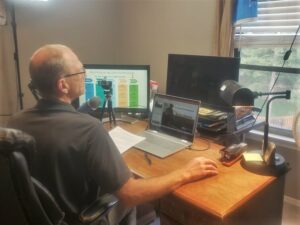Employ every one of the senses in the selling process
Just imagine you are on a 737 heading to Springfield, sitting on the runway in the middle row, squeezed between a loud talker and someone who hasn’t showered in days. The pilot announces that the plane is ready for takeoff, will be headed for Springfield soon, and will be flying at 35,000 feet. Then, she comes back on the intercom and says, “You know folks, I’ve been flying for a long time. I’m not going to use the altimeter, the GPS, nor the airspeed controls. Heck, I’m not even going to turn those controls on. I’m just going to get up there and fly like I know how to fly!” What would you think? My thought would be, “Why not use those tools?” and “How can I get off this plane?”
This is what it’s like as I do a ride along coaching session with a salesperson. They get on the farm and talk for hours without using a visual example of their product. Or they show a visual example but don’t put it in the customer’s hands for them to get a feel for what it’s like.
It’s a tough road out there right now in Ag selling. You know it better than anyone else. Most of our customers are up against narrow margins or below breakeven. Competition is fierce as everyone is trying to improve ROI. Your sales presentations that used to work are being scrutinized harder by your customer. Maybe your competition is putting new ideas in your customer’s mind that isn’t exactly accurate or helpful.
What to do? Do you continue to sell the same way you always have or do you learn to differentiate your selling process? The ultimate goal is to get your point across more effectively. Zig Ziglar used to say that selling is a transference of a feeling. Keep that in mind as you read on. Most salespeople only use two senses in the selling process: sight and hearing. This means they hand their customer a piece of literature and then talk and talk and talk. Or they talk through an endless series of PowerPoint slides. That’s the old tried and true method. That’s what every salesperson does. That’s what every customer is expecting when they see your pickup driving down their farm road.
Today, I want you to start employing all six senses in your selling process. Quit handicapping yourself by using some of the least effective senses. Tap into the most effective senses for transferring a feeling as Zig wanted us to.
- Hearing: Let’s tackle this one first as it is the most often used. We talk and we talk and once in a while, we listen to our customer. However, very rarely do we ever listen to ourselves. It would be rare and a bit strange to pull out a recorder and tape your sales conversation. But if you did, what would you hear? What words or keywords would stand out? Are you descriptive and clarifying when speaking or do you ramble and confuse? Do you plan and even rehearse for those important discussions or do you just “wing it”? My guess is, you wing it. If it’s a critical conversation, take five minutes on your drive to the customer’s farm, turn the talk radio off and practice the actual words you will use? Trust me, this will prove to be one of the best preparations you will ever do!
- Sight: “Seeing is believing” True, but unfortunately this doesn’t apply to your brochures or PowerPoints. Statistics show that customers are skeptical of brand messages. After all, what else would a marketing piece say about their products? Not that you don’t need them nor use them. Go ahead and pull out your brochures and prepared PowerPoint presentations. Just don’t rely on them completely as your customer is skeptical of their bias. Add to this material by showing your customer what actually happens or what they will actually see. A graph or chart showing a 10% increase in yield is great but your producer doesn’t see percentages. How about showing an aerial pictograph of 10 white grain trucks followed by one blue grain truck? You explain, using this program, you will add the blue truck to your operation. You can do the same with any product. Does your product increase weight gain in cattle? Then show a pictograph of how many extra head of cattle this person would get on your product. Show it to them in what they will actually see. Bonus tip: When you or your customer are sitting in their shop or farm office and you can sense there is a lot of confusion about your product or their problem you are trying to solve, ask to go see it. Get your eyes on what is actually going on in this customer’s operation.
- Touch: This is the second most powerful sense in the selling process and too often, we miss great opportunities to use it when selling. Take a tangible piece of your product or service on every sales call. Again, this is not your brochure or flyer. Yes, you need them as mentioned above. To sell with this sense, I want you to bring a physical sample of your product. If you sell a service, then bring an end result of your service or a symbol of what your service will do. For example, above we discussed a series of white trucks and one extra blue truck. Buy a few blue toy trucks for a couple dollars and put one on the table as you explain and show how your product nets a 10% return. Please understand that I am not saying this sells your product. It has to perform as you say it will. The sample or toy, in this case. is merely to drive your point home, differentiate you from every other sales person, and be memorable. Bonus tip: Demo – Demo and Demo some more! Put your customer in the driver’s seat of using your product or service whenever you can. Let them try your new app or software program. Let them experience how easy it is to use your products. This isn’t always possible. However, if it is, let them try it.
- Smell: An extremely powerful sense that doesn’t necessarily connect to every selling situation. If your product is involved in anything that might enhance flavor or prevent odor, then at a minimum talk about it. With feed production, we love to smell ingredients. As if we know what an animal will want. Your product sample will allow the customer to smell it. Standing at countless trade show booths, I can tell you the first thing a customer does is feel the different varieties of feed and will then smell them. Does your product preserve grain or do anything for preserving perishable products? Then use precise words to describe the foul odor of rotting grain from a ground pile and how your product prevents that.
- Taste: I don’t recommend you let your customers taste your products unless you are in the food production business. So, I want to take this in a different direction. I want you to give your customer a “taste” of what it is like to use your products and do business with you. Let them dip their toe in the water so to speak. Allow them a small insight into the many benefits of working with you. If you are selling a product that is a big change for your customer, think of a way they can try one little bite.
- And the Sixth sense (no, it’s not ESP) – it’s Emotion: Ok, technically it’s not a sense, but it is what your customer has when they use all five senses. Your customer sits through your sales call, employs their senses and comes up with a judgment on you. That judgment is used to determine a buying decision. In my sales workshops, when I talk about emotion, most people will initially argue that they don’t want their customers to buy on emotion. What they really mean is they don’t want their customer to be impulsive and buy on unfounded information. They want their customer to weigh the facts and make a logical decision, which I agree. I also explain that “impulsive” is only one emotion in the world. There is a multitude of emotions that are going on in the business of producing crops and livestock. The first and often most important is Fear, which is based on Risk and Return. Producers put large amounts of money, time, health and family heritage at risk every year for a narrow margin. And in today’s market, sometimes they are doing this at negative margins. If your product reduces risk, you need to understand how important that is and talk about it.
As a salesperson, you are conveying information every day on the job. By only employing hearing and vision, you are failing to use 60% (4 out of 6 senses) of your available tools. Maybe you are the best talker in the world and maybe our pilot from the beginning of this article is the greatest pilot in the world, but wouldn’t you want to bring all your resources to the job? I know I want my pilot to at least turn those flight controls back on! And I want you to employ all six senses when selling!




